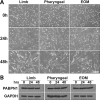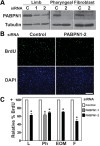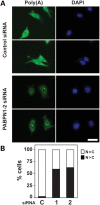Loss of nuclear poly(A)-binding protein 1 causes defects in myogenesis and mRNA biogenesis
- PMID: 20035013
- PMCID: PMC2830829
- DOI: 10.1093/hmg/ddp569
Loss of nuclear poly(A)-binding protein 1 causes defects in myogenesis and mRNA biogenesis
Abstract
The nuclear poly(A)-binding protein 1 (PABPN1) is a ubiquitously expressed protein that plays a critical role in polyadenylation. Short expansions of the polyalanine tract in the N-terminus of PABPN1 lead to oculopharyngeal muscular dystrophy (OPMD), which is an adult onset disease characterized by eyelid drooping, difficulty in swallowing and weakness in the proximal limb muscles. Although significant data from in vitro biochemical assays define the function of PABPN1 in control of poly(A) tail length, little is known about the role of PABPN1 in mammalian cells. To assess the function of PABPN1 in mammalian cells and specifically in cells affected in OPMD, we examined the effects of PABPN1 depletion using siRNA in primary mouse myoblasts from extraocular, pharyngeal and limb muscles. PABPN1 knockdown significantly decreased cell proliferation and myoblast differentiation during myogenesis in vitro. At the molecular level, PABPN1 depletion in myoblasts led to a shortening of mRNA poly(A) tails, demonstrating the cellular function of PABPN1 in polyadenylation control in a mammalian cell. In addition, PABPN1 depletion caused nuclear accumulation of poly(A) RNA, revealing that PABPN1 is required for proper poly(A) RNA export from the nucleus. Together, these experiments demonstrate that PABPN1 plays an essential role in myoblast proliferation and differentiation, suggesting that it is required for muscle regeneration and maintenance in vivo.
Figures





Similar articles
-
Functional impact of an oculopharyngeal muscular dystrophy mutation in PABPN1.J Physiol. 2017 Jul 1;595(13):4167-4187. doi: 10.1113/JP273948. Epub 2017 Apr 25. J Physiol. 2017. PMID: 28303574 Free PMC article.
-
Cytoplasmic targeting of mutant poly(A)-binding protein nuclear 1 suppresses protein aggregation and toxicity in oculopharyngeal muscular dystrophy.Traffic. 2005 Sep;6(9):766-79. doi: 10.1111/j.1600-0854.2005.00315.x. Traffic. 2005. PMID: 16101680
-
HnRNP A1 and A/B interaction with PABPN1 in oculopharyngeal muscular dystrophy.Can J Neurol Sci. 2003 Aug;30(3):244-51. doi: 10.1017/s0317167100002675. Can J Neurol Sci. 2003. PMID: 12945950
-
PABPN1: molecular function and muscle disease.FEBS J. 2013 Sep;280(17):4230-50. doi: 10.1111/febs.12294. Epub 2013 May 24. FEBS J. 2013. PMID: 23601051 Free PMC article. Review.
-
Oculopharyngeal muscular dystrophy: recent advances in the understanding of the molecular pathogenic mechanisms and treatment strategies.Biochim Biophys Acta. 2007 Feb;1772(2):173-85. doi: 10.1016/j.bbadis.2006.10.003. Epub 2006 Oct 11. Biochim Biophys Acta. 2007. PMID: 17110089 Review.
Cited by
-
Implications of Poly(A) Tail Processing in Repeat Expansion Diseases.Cells. 2022 Feb 15;11(4):677. doi: 10.3390/cells11040677. Cells. 2022. PMID: 35203324 Free PMC article. Review.
-
Post-transcriptional regulation of Pabpn1 by the RNA binding protein HuR.Nucleic Acids Res. 2018 Sep 6;46(15):7643-7661. doi: 10.1093/nar/gky535. Nucleic Acids Res. 2018. PMID: 29939290 Free PMC article.
-
Targeting the Polyadenylation Signal of Pre-mRNA: A New Gene Silencing Approach for Facioscapulohumeral Dystrophy.Int J Mol Sci. 2018 May 3;19(5):1347. doi: 10.3390/ijms19051347. Int J Mol Sci. 2018. PMID: 29751519 Free PMC article. Review.
-
Cytoskeletal disorganization underlies PABPN1-mediated myogenic disability.Sci Rep. 2020 Oct 19;10(1):17621. doi: 10.1038/s41598-020-74676-8. Sci Rep. 2020. PMID: 33077830 Free PMC article.
-
Mutation of the conserved polyadenosine RNA binding protein, ZC3H14/dNab2, impairs neural function in Drosophila and humans.Proc Natl Acad Sci U S A. 2011 Jul 26;108(30):12390-5. doi: 10.1073/pnas.1107103108. Epub 2011 Jul 6. Proc Natl Acad Sci U S A. 2011. PMID: 21734151 Free PMC article.
References
-
- Kuhn U., Wahle E. Structure and function of poly(A) binding proteins. Biochim. Biophys. Acta. 2004;1678:67–84. - PubMed
-
- Kuhn U., Nemeth A., Meyer S., Wahle E. The RNA binding domains of the nuclear poly(A)-binding protein. J. Biol. Chem. 2003;278:16916–16925. - PubMed
-
- Fan X., Dion P., Laganiere J., Brais B., Rouleau G.A. Oligomerization of polyalanine expanded PABPN1 facilitates nuclear protein aggregation that is associated with cell death. Hum. Mol. Genet. 2001;10:2341–2351. - PubMed
-
- Calado A., Tome F.M., Brais B., Rouleau G.A., Kuhn U., Wahle E., Carmo-Fonseca M. Nuclear inclusions in oculopharyngeal muscular dystrophy consist of poly(A) binding protein 2 aggregates which sequester poly(A) RNA. Hum. Mol. Genet. 2000;9:2321–2328. - PubMed
Publication types
MeSH terms
Substances
Grants and funding
LinkOut - more resources
Full Text Sources
Other Literature Sources
Molecular Biology Databases
Research Materials

